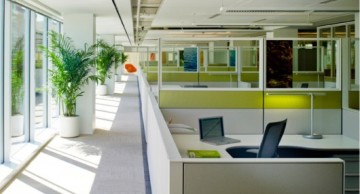Buildings emissions: Though the COVID-19 lockdowns showed a dramatic drop in electricity demand at the industrial level, it was partially compensated by higher residential uses. With eased confinement, energy demand took the first sign of recovering very quickly. It clearly indicates that unless there is a fundamental change in design and strategy, cutting the carbon footprints are near to impossible. Even without considering indirect emissions (i.e. emissions from power generation by fossil fuel), the buildings and construction sector are responsible for a significant share of energy use and emissions. In 2017, indirect emissions (around 70% of total buildings‐related emissions) were the overriding share of energy‐related CO2 emissions in the buildings sector and when buildings constructions (i.e. manufacturing of building materials) are included, total buildings‐related CO2 emissions amounted to more than 11 GtCO2 in 2017 or 39% of the global energy‐related emissions [1]. Due to the acceleration of urbanization, floor space is increasing with more electricity-dependent technologies which are adding extra pressure in the energy uses. 2.48 trillion square feet (230 billion m2) of new floor areas are expected to add to the global building stock, doubling it by 2060 [2].
Energy consumptions by end uses: In the building sector, energy-consuming end uses include space heating, space cooling, water heating, lighting, cooking and appliances. Space heating accounts for almost half (42%) of the residential energy use in G20 countries followed by Appliances (17%) and water heating (16%) as major contributors (Figure 1). In G20, the European Union has the highest share in space heating where the UK is considerably, the highest with 71% consumption in the residential sector (Figure 2).
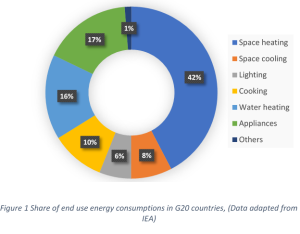
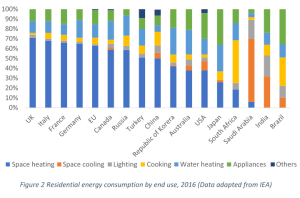
Although warmer countries have lower space heating requirements and only 20% of G20 countries have extreme summer temperatures, space cooling that uses mechanical cooling equipment is a growing tension for energy demand. While cooling accounts for 8% of total residential energy consumption in G20 countries (Figure 1), it is the fastest-growing demand in building end uses. Increased affordability and ownerships of air conditioning are creating pressure on electricity demand for the near future. Hence, there is a huge necessity of saving energy from these end uses by implementing efficient technologies with appropriate regulations.
Green buildings and energy efficiency: Green buildings are the most efficient practices in the fight against building-related emissions worldwide. The average LEED certified building uses 32% less electricity and saves 350 metric tons of CO2 emissions annually [USGBC]. According to World Green Building Council, “a ‘green’ building is a building that, in its design, construction or operation, reduces or eliminates negative impacts, and can create positive impacts, on our climate and natural environment.” Zero energy buildings are by definition focusing on reducing their negative impacts through increased energy savings. In planning, construction and operation phase, and regardless of the definition of a zero energy building, minimizing the energy use through efficient building design is one of the fundamental requirements of green buildings. Many countries are aiming to achieve net zero energy buildings by 2050 through building codes, appliance standards, planned investment, and retrofitting policies.
Energy efficiency is the most cost-effective measure that will offset the cost of renewable energy projects in a broader energy demand. With proper building design and energy-efficient features, demand-side loads can be minimized. However, studying best practices of green buildings projects, it is observed that lighting delivers the highest positive aspects as end use improvements followed by HVAC development (Figure 3). The energy efficient approaches of green building construction frequently include passive and active approaches followed by the integration of digitalization (Figure 4). The passive approach includes high-performance envelopes, air barrier systems, daylighting, efficient facades, careful selection of windows and glazing, passive solar heating, ground cooling, natural ventilation, etc. Once building loads are decreased by passive design strategies; active approaches such as energy-efficient lighting, advanced lighting controls, efficient appliances, mechanical air heat recovery, displacement ventilation, radiant heating/cooling, heat pumps and more can be applied to cut additional energy uses in the building. Digitalization helps in controlling energy use further in an advanced way by enabling the optimal operation of all energy-efficient appliances and building equipment.
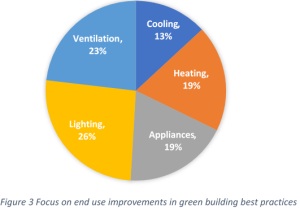
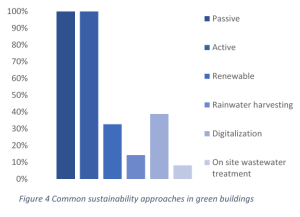
There are multiple benefits in energy-efficient buildings, including CO2 reduction, future energy security, and the potential of saving substantial amount of energy bills without compromising comfort. Indoor air quality and moisture levels could be improved by enabling consumers to control their energy use by being more resource-efficient.
Below are the number of key drivers that are identified in this study towards energy efficiency commitments:
- Regulations on building codes and equipment standards.
- Shift in the market by new technology, new business opportunity
- Energy savings, money savings
- Sustainable building design
- Lack of fuel ownership enables efficient use of energy
- Subsidies for energy-efficient technologies
- Awareness of climate change among policy makers
- Consumer engagement in energy efficiency practices, etc.
Demand for energy in buildings will be increasing with population, activities and floor areas. The increased use of technologies with growing floor areas will put more stress in the power supply system. So, fast actions are needed against the foreseeable energy poverty and building emissions, and hence, green buildings are the only option towards a sustainable built environment.

